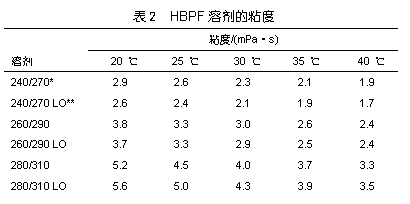5 Development of replacing petroleum solvent components with petrochemical alternatives
Several years ago the authors began to study the viscoelastic properties of HBPF solvents and the so-called capillary absorption phase during the drying of four-color lithography on precoated paper. The researchers' interest is in the influence of temperature on the solvent absorption speed, and the short-wave infrared energy acceleration drying process can be used.

Table 2 shows the viscosity range of HBPF solvents at different temperatures. A decrease in viscosity means that the solvent component can penetrate more quickly into the pores of the paper. Heating the plate with infrared radiation after printing should increase the curing speed of the ink coating film and accelerate the automatic oxidation and drying of the ink during the placement of the printed plate material (see Figure 6). Fast curing is not required in all paper printing applications. A special case of using HBPF solvent alternatives is to use with vegetable oils for offset lithographic inks in paper multicolor wireless offset processes such as 4-to-4 processes A lower "sticky peak" was obtained in the printing. The use of vegetable oil inks is discussed in the article and it is pointed out that in addition to its use in 4-to-4 machines, such inks work too slowly for high speed printers.

A simple test was designed to compare the rate of absorption of different solvents and vegetable oils on various uncoated or precoated papers. The results confirmed that the solvents used for hydrocarbon inks have significantly different absorption characteristics from vegetable oils. It was found that unsaturated fatty acid methyl ester is a clean printing aid that can replace conventional volatile solvents, and can also be used as a substitute for high-boiling solvents for lithographic ink base materials.



Figures 7, 8, and 9 show that the two methyl esters have absorption characteristics close to 280/310 HBPF solvent. Rapeseed oil fatty acid methyl ester has been used as a base material for newly developed waterless offset inks. Tung oil fatty acid methyl esters have been developed for use in offset printing inks. The latter derivatives help to improve the film forming properties and low viscosity components as a base material.
6 Non-knocking printing process and ink development
Previous articles have also mentioned the need to increase activity in ink jet and electrophotographic printing. This research is continuing. An article on general purpose ink jets provides an overview of the digital printing process and highlights the dro on demand technology. Pigments and dyes have been used extensively in continuous and thermal inkjet inks. The physical properties of a typical thermal ink jet ink formulation are provided, and inks of different specifications for low viscosity (1~5 mPa·s) and high viscosity (1~20 mPa·s) for piezoelectric processes are compared. The versatility of the latter process makes it possible to use solid (eg hot wax), solvent-based, water-based oils and alcohol-soluble or UV-curing inks. Future developments in inks and standard media substrates will require replacement of expensive special media that require print fastness and durability.
Color chemistry plays an important role in the development of inks. Professional manufacturers of pigments and dyes have developed more refined dyes to provide optimal performance - high water solubility in water-soluble inks, and zero water solubility when the inks are used on slightly acidic papers. The recent developments in inks are to obtain complete water fastness in an instant while maintaining its hue, light fastness, and reliability. For this reason, the synthesis and stereochemistry of amphoteric compounds have recently been adopted. The azo-based and polycyclic dyes and pigments selected for inkjet inks were studied to obtain yellow, magenta, cyan, and black colorants.
The question arises, “Do digital technology methods and inks replace equipment in traditional packaging and printing?†Electrographic technology was used in the study of digital printing performance for the printing of various substrates (paper, film, and metal film). . Compared to offset printing and gravure printing (400 to 900 feet/min), digital printing speeds are very low (20 to 25 feet/min). With regard to the requirements for food packaging, the best adhesion between the ink and the substrate, the film needs to be coated with primer, chromium treatment or surface modification, the residual solvent is also a problem (derived from the liquid toner Hydrocarbon solvents), even in laminated structures. Due to the thermoplastic characteristics of the toner, heat resistance problems arise. In some packaging applications, digital printing has not yet shown a real threat to conventional offset printing, gravure printing or offset lithography, but its print quality is good.
For ink toners, the use of only the thermoplastic resin component will not achieve versatility and the desired properties for various types of packaging substrates. On the other hand, a wide variety of resins and polymer solutions can be used in offset printing and gravure printing inks to meet specific substrate and end-use needs.
Discussions on the progress of digital printing show that traditional printing technologies that have been used for a long time are still unlikely to be replaced by digital technologies. It is expected that inkjet will become a competitive printing technology. Digital printing can dominate in some printing fields and can grow at high speeds.
Source: Coatings Technology Information Network
Taihe Fangyuan Muye Co.,Ltd , https://www.fyofficefurniture.com
![<?echo $_SERVER['SERVER_NAME'];?>](/template/twentyseventeen/skin/images/header.jpg)